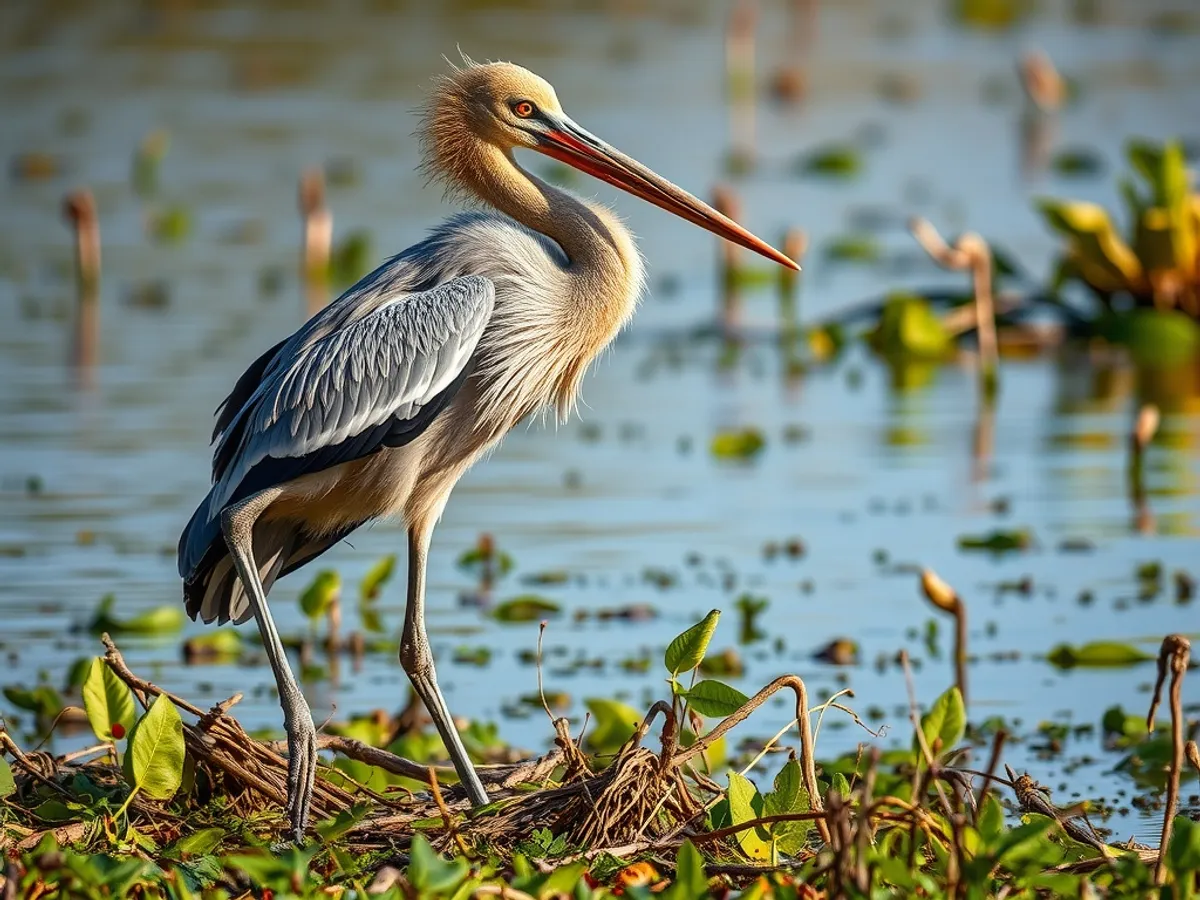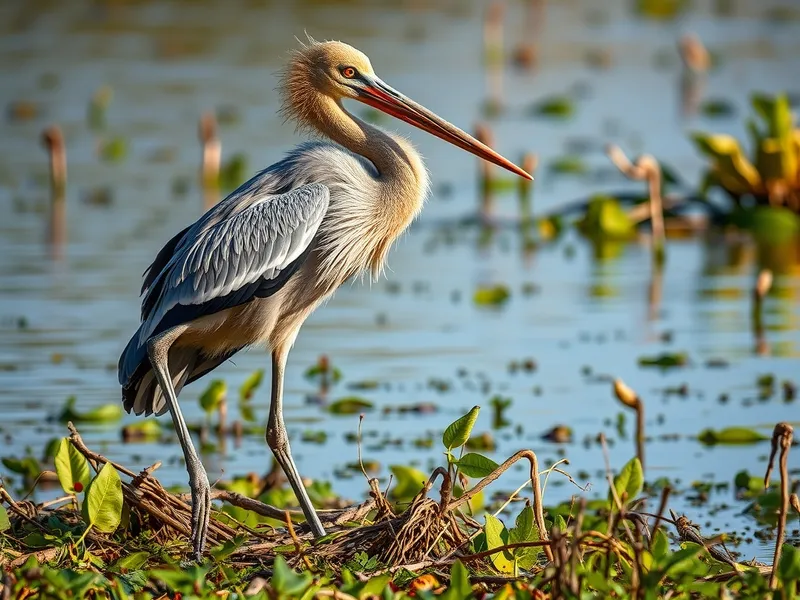
Shoebill Stork
Balaeniceps rex

Meet the Shoebill Stork
The Shoebill Stork is a large, enigmatic bird known for its massive, shoe-shaped bill and imposing presence. Native to the swamps and wetlands of central tropical Africa, it is a solitary hunter, often standing motionless for hours while waiting for prey. Its plumage is predominantly grey, and it can reach nearly 1.5 meters in height, with a wingspan up to 2.5 meters. Despite its stork-like appearance, it is more closely related to pelicans and herons.
Classification
Bird
Habitat
Freshwater swamps and wetlands
Diet
Carnivore
Lifespan
35-40 years
Conservation
Vulnerable
Weight
4-7 kg
📖Fascinating Facts
Impressive Bill
The Shoebill's bill can reach up to 24 cm (9.4 in) long and 20 cm (7.9 in) wide, perfectly adapted for catching slippery prey like lungfish.
Motionless Hunter
Shoebills often stand still for long periods, waiting patiently for the right moment to strike at unsuspecting prey.
Selective Parenting
Shoebills usually lay two eggs but typically only raise one chick, as the stronger sibling often outcompetes the other for food.
📋Detailed Description
The Shoebill Stork (Balaeniceps rex) is a strikingly large bird, reaching heights of 110–140 cm (43–55 in) and weighing between 4 to 7 kg (8.8–15.4 lbs). Its most distinctive feature is its massive, shoe-shaped bill, measuring up to 24 cm (9.4 in) long and 20 cm (7.9 in) wide, equipped with sharp edges and a hooked tip for grasping slippery prey. The plumage is slate-grey, with darker flight feathers and a paler underside, while juveniles exhibit browner tones. The head is large, with prominent yellow eyes and a feathered crest at the nape. The legs are long and robust, adapted for wading through dense aquatic vegetation. Shoebills are primarily solitary, exhibiting territoriality over feeding and nesting sites. They are renowned for their statue-like hunting posture, standing motionless for extended periods before executing rapid, powerful strikes. Their vocalizations are unusual for large birds, including bill-clattering and deep, guttural moos, especially during nesting. Despite their common name, genetic studies place them closer to pelicans (Pelecaniformes) than true storks (Ciconiiformes). The species is highly specialized for life in papyrus swamps and floodplains, where it preys on large fish, amphibians, and occasionally reptiles and small mammals.
💡 Did you know?
Despite its intimidating look, the Shoebill is extremely shy and avoids human contact, making sightings in the wild quite rare.
🔬Research & Sources
🎭Behavior & Social Structure
Shoebills are predominantly crepuscular, with peak activity at dawn and dusk, though they may hunt throughout the day. Their hunting strategy is characterized by extreme patience: they stand motionless or move slowly through shallow water, waiting for prey to surface. When prey is detected, the shoebill launches a sudden, forceful lunge, often submerging its bill and head to capture fish such as lungfish, catfish, and tilapia. They are capable of swallowing large prey whole, using their powerful bill to decapitate or crush if necessary. Social interactions are minimal outside the breeding season; adults are highly territorial and will aggressively defend feeding grounds from conspecifics. Juveniles may exhibit some social tolerance, but adults are almost always solitary. Shoebills spend significant time preening and sunning themselves, and may roost on floating vegetation or low branches at night.
👶Reproduction & Life Cycle
Shoebill breeding is closely tied to the dry season, which varies regionally but generally occurs from April to August. Pairs are monogamous for the season and establish large territories in undisturbed wetlands. The nest is a massive platform of aquatic vegetation, often over 1–3 meters in diameter, built on floating mats or solid ground surrounded by water. Females typically lay 1–3 eggs, but siblicide is common, with only one chick usually surviving to fledging. Incubation lasts about 30 days, shared by both parents, who also provide extensive brooding and shading to protect chicks from overheating. Chicks are fed regurgitated fish and require intensive care for the first few weeks. Fledging occurs at 95–105 days, but juveniles may remain dependent on parents for several months. Breeding success is highly sensitive to water levels and human disturbance.
🛡️Adaptations & Survival
The shoebill's enormous bill is a key adaptation, enabling it to capture and handle large, slippery prey such as lungfish and eels. The bill's sharp edges and hooked tip facilitate both grasping and dismembering prey. Long legs and large, unwebbed feet allow for efficient movement through floating vegetation and shallow water. Their cryptic grey coloration provides camouflage among papyrus and reeds. Behavioral adaptations include extreme patience and stealth during hunting, as well as the ability to regulate body temperature by panting and gular fluttering. Shoebills have evolved a low reproductive rate, with high parental investment in a single offspring, likely as an adaptation to unpredictable wetland environments.
📚Research Sources
🎨Cultural Significance
The shoebill is a symbol of mystery and rarity in central African cultures, often regarded with awe due to its unusual appearance and solitary habits. In some local traditions, it is considered a harbinger of good or bad fortune, and its presence is sometimes used as an indicator of healthy wetlands. The bird has gained international attention as a flagship species for wetland conservation and is featured in ecotourism initiatives in Uganda and Zambia. There are no widespread traditional uses of the bird itself, but its image is increasingly used in conservation education and awareness campaigns.
🔬Recent Research & Discoveries
Recent genetic studies have clarified the shoebill's phylogenetic position, confirming its closer relationship to pelicans than to storks. Ongoing research focuses on its breeding ecology, habitat requirements, and the impacts of climate change on wetland hydrology. Satellite telemetry and camera traps are being used to monitor movements and nesting success in remote areas. Studies have highlighted the importance of undisturbed wetlands for successful reproduction and the negative effects of human encroachment. Conservation programs are increasingly involving local communities in nest protection and wetland management, with positive outcomes for both shoebills and other wetland species.
🎥Wildlife Videos

The Dark Side of Shoebill Chicks | Africa | BBC Earth
The rivalry between two shoebill chicks becomes apparent when their mother leaves to fetch water. Taken from Africa. Subscribe ...
BBC Earth

SHOEBILL STORK ─ The Jurassic Master Hunter of The Wetlands! Shoebill vs Lungfish
Witness the commanding presence of the SHOEBILL STORK, an iconic hunter in the wetlands. Marvel at its striking ...
BEASTERS

Top 5 David Attenborough Moments | BBC Earth
The voice that has characterised over 60 years of natural history content at the BBC - here are our top 5 David Attenborough ...
BBC Earth

Shoebills are Metal
When you see a shoebill you might think that they look like dinosaurs - and the awesome thing is, they actually are dinosaurs.
Animalogic

Your Life as a Shoebill
This is what your life would've been like if you were born as a Shoebill, also know as the whale head king, bog bird or swamp king ...
James Toland

The Shoebill is the strangest bird in the world.
The Shoebill is the strangest bird in the world. The Shoe-billed stork (Balaeniceps rex) is a large broad-winged bird that lives in ...
Other Mind
🌍Habitat Information
The Shoebill Stork typically inhabits Freshwater swamps and wetlands environments. Shoebill Storks have adapted to their environments with specialized features and behaviors.
Primary Habitat:
Freshwater swamps and wetlands
More detailed habitat information will be available soon.
🛡️Conservation Status
The Shoebill Stork is currently classified as Vulnerable. Conservation efforts are crucial for preserving this species for future generations.
Common Threats:
- 🏠Habitat loss and fragmentation
- 🌡️Climate change impacts
- 🎯Hunting and poaching
- 🏭Human-wildlife conflict
⚠️Threats & Conservation Challenges
The primary threats to shoebills are habitat loss and degradation due to wetland drainage, conversion to agriculture, and infrastructure development. Human disturbance, especially during the breeding season, can cause nest abandonment. Illegal capture for the wildlife trade, particularly for private collections and zoos, poses a significant risk in some regions. Climate change and altered hydrology further threaten the stability of wetland habitats. Population estimates suggest fewer than 5,000–8,000 mature individuals remain, with a declining trend. Conservation challenges include the need for effective wetland protection, community engagement, and enforcement against illegal trade.
🔬Scientific Classification
Scientific Name
Balaeniceps rex
Classification Hierarchy
🔍 About Taxonomic Classification
Taxonomic classification is a hierarchical system used by scientists to classify and organize living organisms based on shared characteristics and evolutionary relationships.
The system moves from broad categories (Kingdom) to increasingly specific ones, with each animal's scientific name typically consisting of its Genus and species.
📝Community Notes
Share your observations and insights about the Shoebill Stork with our community of wildlife enthusiasts.
Join Our Community
Sign in to share your observations and connect with fellow wildlife enthusiasts.
Sign In to ContributeNo community notes yet
Be the first to share your observations about the Shoebill Stork!
Explore Shoebill Stork
Select a tab above to learn more about this amazing animal.
📸Photo Gallery
No photos available for this animal yet.
🌟Discover More Wildlife
Continue your journey of discovery with more fascinating animals from our database
